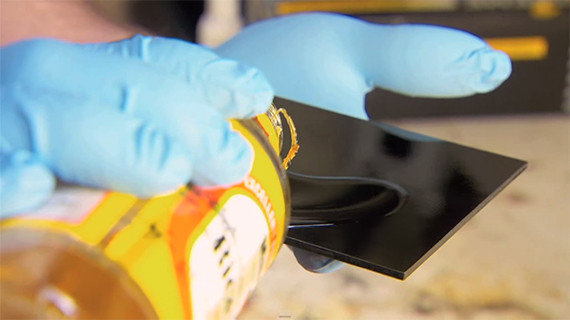In this era of digital photography, Instagram, and iPhoneography, it’s hard to imagine that someone is still doing photography the old fashioned way. To be precise Giles Clement uses a process that dates back 150 years. Naturally, the question that comes to mind is why? It isn’t just about doing it for the heck of it; Clement thinks it’s kind of addictive. He never gets bored with it:
Wet Plate Collodion Process
The wet plate collodion process gets its name from the fact that it involves the use of wet chemicals. Collodion is prepared using cotton, alcohol, ether, and acid. It’s poured onto a piece of black glass. The glass piece is then dumped into a tank of silver nitrate which reacts with the collodion and creates a light sensitive surface. The light sensitive glass plate is then loaded into the back of a metal frame that has an opaque slide. The whole thing is then loaded into the back of a camera.

Collodion is poured over a piece of black glass.
The wet plate collodion process was developed back in 1851 and was used until about 100 years ago. The process took a back seat to the in-thing those days—film—which in turn got shoved off by digital photography later on. Without photographers like Clement, the process would have completely taken the route of the Dodo.

Clement’s lens
The lens Clement uses for taking pictures with this process was built in—brace yourself—1849! It was designed for cameras that pre-dates the wet plate process. When a subject is ready to be photographed, the wet plate is loaded at the back of the camera, the lens cap, which is actually a black hat, is taken off, and the plate is exposed. A flash is fired the instant the exposure is made.
In order to develop the plate, Clement pours the developer directly onto it. As the plate is developed, a negative image appears. The developed plate is then placed in a tank containing the fixer. This is where the magic happens. The final image appears seemingly out of nowhere.
Why Bother?
So with all the technology that we do have at our disposal today, why even bother doing something like this? Clement explains, “Digital picture and Instagram or whatever—it’s here one second and you forget about it the next. It’s on your hard drive somewhere and this is something that you can hang on your wall and it’s going to last for 200 years or more.”

Wet Plate Photo
For those who started off in film and for whom the darkroom was actually a small dark room where images came to life, the gradual and painful death of film is a very disconcerting experience. For them, the process of developing a roll of film and watching it come to life was an integral part of photography itself. It was painstaking work, but it was highly satisfactory at the end of the day. The wet plate process just takes that satisfaction level a rung higher.
Like This Article?
Don't Miss The Next One!
Join over 100,000 photographers of all experience levels who receive our free photography tips and articles to stay current:






I must say, Digital has revolutionized photography. However, the old ways are still superior. Look at the image that goes along with this article. The detail in her face, the almost 3d quality to the shawl… I have never seen a digital camera capture an image as astonishing as this.
I will admit that I usually shoot digital these days. However, I still have my darkroom, and I still love spending all day in it. The technique is an art all to itself.I recently shot a roll of old Gilford stock I had laying around, and was drawn into the organic nature of the grain. By the end of the day, I was out trying to find more film to shoot. I dream of the day that I can get an 8×10 camera with a gold dot dagor, and make my own glass plates coated in homemade emulsion from eggs and silver nitrate… Okay, whatever, I am a photography geek… at least I’m not the only one
I started in photography about 1949 with a Brownie Hawkeye. Soon I was working in a commercial darkroom processing hundreds, no thousands of paper positives in a massive Kodak processor. I worked in Newspaper darkrooms, portrait studios and sold cameras and equipment in stores.Along the way I built my own darkroom with black plastic film in the basement and tried my hand at building cameras and restoring old ones. I also experimented with developers to produce very fast speeds with fine grain results. Those two interests were seemingly at opposition to one another, but I had some interesting and pleasing results.
One extremely gratifying experience was when I set up to develop color slides in a field darkroom, actually a temporary setup in an unused men’s room. I was told by engineers at Eastman Kodak that I was one of very few who ever pulled that off.
As stated, it is fascinating, and gets in your blood, but after decades I finally moved toward digital photography and eventually adopted the science and art completely.
I’m retired now and practice my craft privately with a great deal of pleasure.
I must say, retouching and restoration is far more satisfactory than it was with the old ways. Digital Post processing is also very much more gratifying than dodging, burning and cut and paste then copy.
It’s been a great ride and I’ll keep going as long as I can.
Don Butler age 81 as of Feb. 7, 2015.